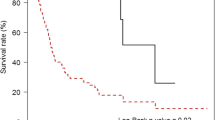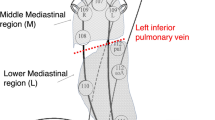Abstract
Background
CT is the most commonly used method to stage esophageal cancer (EC). However, the reported CT T-staging criteria for EC are controversial.
Purpose
To determine and validate the optimal esophageal wall thickness (EWT) threshold on CT to distinguish lesions with different T stages in esophageal squamous cell carcinoma (ESCC) patients.
Methods
One thousand, one hundred-two consecutive patients with histopathologically confirmed ESCC between July 2014 and April 2020 were retrospectively reviewed. All patients underwent a preoperative CT examination and surgical treatment. The maximal EWT of the lesions on CT was measured. Patients were divided into pT1, pT2, pT3 and pT4 subgroups according to the pathologic stage. We employed the support vector machine, where linear kernels were leveraged to determine the optimal threshold to classify samples with different T stages. 90% of samples from each subgroup were randomly selected as the training set, while the remainder comprised the testing set.
Results
The mean EWTs of the pT1, pT2, pT3 and pT4 subgroups were 4.9 ± 2.6 mm, 8.1 ± 2.3 mm, 12.4 ± 3.6 mm, and 18.6 ± 4.4 mm, respectively. Differences in the EWT between the four subgroups or between adjacent subgroups were significant (p < 0.001), and esophageal wall became thicker with increasing pT stage. We utilized MATLAB 2020a to implement the SVM model and ran the code 10 times. The accuracy of the model was 60.29 ± 2.33%. The thresholds between samples from pT1/pT2, pT2/pT3 and pT3/pT4 lesions were 5.5 ± 0.3 mm, 10.8 ± 0.8 mm and 15.9 ± 0.5 mm, respectively.
Conclusions
Possibility of predicting T stage of ESCC by EWT on CT scans was limited to 60% by model examination with large sample size.


Similar content being viewed by others
Abbreviations
- EC:
-
Esophageal cancer
- ESCC:
-
Esophageal squamous cell carcinoma
- EWT:
-
Esophageal wall thickness
- SVM:
-
Support vector machine
- EUS:
-
Endoscopic ultrasound
- AJCC:
-
American Joint Committee on Cancer
- PACS:
-
Picture archiving and communication system
- ANOVA:
-
Analysis of variance
References
Bray F, Ferlay J, Soerjomataram I, et al. Global cancer statistics 2018: GLOBOCAN estimates of incidence and mortality worldwide for 36 cancers in 185 countries. CA A Cancer J Clin. 2018;68(6):394–424.
Lee H-S, Jung H-K, Tae CH, et al. Treatment pattern and overall survival in esophageal cancer during a 13-year period: a nationwide cohort study of 6,354 Korean patients. PLoS ONE. 2020;15(4):e0231456.
Cai Z, Liu Q. Understanding the Global Cancer Statistics 2018: implications for cancer control. Sci China Life Sci. 2021;64(6):1017–20.
Li B, Li N, Liu S, et al. Does [18F] fluorodeoxyglucose–positron emission tomography/computed tomography have a role in cervical nodal staging for esophageal squamous cell carcinoma? J Thorac Cardiovasc Surg. 2020;160(2):544–50.
Krill T, Baliss M, Roark R, et al. Accuracy of endoscopic ultrasound in esophageal cancer staging. J Thorac Dis. 2019;11(S12):S1602–9.
Choi J, Kim SG, Kim JS, et al. Comparison of endoscopic ultrasonography (EUS), positron emission tomography (PET), and computed tomography (CT) in the preoperative locoregional staging of resectable esophageal cancer. Surg Endosc. 2010;24(6):1380–6.
Deng J, Chu X, Ren Z, et al. Relationship between T stage and survival in distantly metastatic esophageal cancer: A STROBE-compliant study. Medicine. 2020;99(19):e20064.
He LJ, Xie C, Wang ZX, et al. Submucosal saline injection followed by endoscopic ultrasound versus endoscopic ultrasound only for distinguishing between T1a and T1b esophageal cancer. Clin Cancer Res. 2020;26(2):384–90.
Lee G, I H, Kim SJ, , et al. Clinical implication of PET/MR imaging in preoperative esophageal cancer staging: comparison with PET/CT, endoscopic ultrasonography, and CT. J Nucl Med. 2014;55(8):1242–7.
Sandha GS, Severin D, Postema E, et al. Is positron emission tomography useful in locoregional staging of esophageal cancer? Results of a multidisciplinary initiative comparing CT, positron emission tomography, and EUS. Gastrointest Endosc. 2008;67(3):402–9.
Pfau PR, Perlman SB, Stanko P, et al. The role and clinical value of EUS in a multimodality esophageal carcinoma staging program with CT and positron emission tomography. Gastrointest Endosc. 2007;65(3):377–84.
Iyer RB, Silverman PM, Tamm EP, et al. Diagnosis, staging, and follow-up of esophageal cancer. AJR Am J Roentgenol. 2003;181(3):785–93.
Wu LF, Wang BZ, Feng JL, et al. Preoperative TN staging of esophageal cancer: comparison of miniprobe ultrasonography, spiral CT and MRI. World J Gastroenterol. 2003;9(2):219–24.
Chen M, Li X, Chen Y, et al. Proposed revision of the 8th edition AJCC clinical staging system for esophageal squamous cell cancer treated with definitive chemo-IMRT based on CT imaging. Radiat Oncol. 2019;14(1):54.
Cheng ZZ, Yang NJ, Xi XQ, et al. Diagnostic and application value of 64-slice spiral CT scanning in preoperative staging of esophageal cancer. Zhonghua Zhong Liu Za Zhi. 2011;33(12):929–32.
Moschetta M, Ianora AA, Marzullo A, et al. Vessel probe CT protocol in the study of esophageal carcinoma: can it improve preoperative T staging? Eur J Surg Oncol. 2010;36(7):663–9.
Lowe VJ, Booya F, Fletcher JG, et al. Comparison of positron emission tomography, computed tomography, and endoscopic ultrasound in the initial staging of patients with esophageal cancer. Mol Imaging Biol. 2005;7(6):422–30.
Botet JF, Lightdale CJ, Zauber AG, et al. Preoperative staging of esophageal cancer: comparison of endoscopic US and dynamic CT. Radiology. 1991;181(2):419–25.
Moss AA, Schnyder P, Thoeni RF, et al. Esophageal carcinoma: pretherapy staging by computed tomography. Am J Roentgenol. 1981;136(6):1051–6.
Rice TW, Ishwaran H, Ferguson MK, et al. Cancer of the esophagus and esophagogastric junction: an eighth edition staging primer. J Thorac Oncol. 2017;12(1):36–42.
Hu CY, Li YK, Li JB, et al. A comparative study of the normal oesophageal wall thickness based on 3-dimensional, 4-dimensional, and cone beam computed tomography. Medicine. 2020;99(45):e22553.
Panebianco V, Grazhdani H, Iafrate F, et al. 3D CT protocol in the assessment of the esophageal neoplastic lesions: can it improve TNM staging? Eur Radiol. 2006;16(2):414–21.
Yamabe Y, Kuroki Y, Ishikawa T, et al. Tumor staging of advanced esophageal cancer: combination of double-contrast esophagography and contrast-enhanced CT. AJR Am J Roentgenol. 2008;191(3):753–7.
Thompson WM, Halvorsen RA Jr. Staging esophageal carcinoma II: CT and MRI. Semin Oncol. 1994;21(4):447–52.
Picus D, Balfe DM, Koehler RE, et al. Computed tomography in the staging of esophageal carcinoma. Radiology. 1983;146(2):433–8.
Umeoka S, Koyama T, Watanabe G, et al. Preoperative local staging of esophageal carcinoma using dual-phase contrast-enhanced imaging with multi-detector row computed tomography: value of the arterial phase images. J Comput Assist Tomogr. 2010;34(3):406–12.
Sultan R, Haider Z, Chawla TU. Diagnostic accuracy of CT scan in staging resectable esophageal cancer. J Pak Med Assoc. 2016;66(1):90–2.
Walker AJ, Spier BJ, Perlman SB, et al. Integrated PET/CT fusion imaging and endoscopic ultrasound in the pre-operative staging and evaluation of esophageal cancer. Mol Imaging Biol. 2011;13(1):166–71.
Acknowledgements
This study is supported by the Natural Science Foundation of Shandong Province (ZR2019PH115).
Author information
Authors and Affiliations
Corresponding authors
Ethics declarations
Conflict of interest
The authors declare that they have no confict of interest.
Ethical statement
All procedures performed in studies involving human participants were in accordance with the standards of the institutional and/or national research committee and with the 1964 Helsinki declaration and its later amendments or comparable ethical standards. Formal consent is not required for this retrospective study.
Additional information
Publisher's Note
Springer Nature remains neutral with regard to jurisdictional claims in published maps and institutional affiliations.
Rights and permissions
About this article
Cite this article
Wang, Y., Huang, Y., Zhao, Qy. et al. Esophageal wall thickness on CT scans: can it predict the T stage of primary thoracic esophageal squamous cell carcinoma?. Esophagus 19, 269–277 (2022). https://doi.org/10.1007/s10388-021-00886-2
Received:
Accepted:
Published:
Issue Date:
DOI: https://doi.org/10.1007/s10388-021-00886-2




